Date: 8 May, 2025
Venue: Online
Watch the Recordings
Sri Aurobindo once wrote about Rabindranath Tagore:
“Tagore has been a wayfarer towards the same goal as ours in his own way — that is the main thing, the exact stage of advance and putting of the steps are minor matters. His exact position as a poet or a prophet or anything else will be assigned by posterity…”
~ CWSA, 27: 385
On May 8, 2025, BhāratShakti team celebrated Rabindrajayanti and the legacy of Rabindranath Tagore through a webinar titled Celebrating Tagore: “The Song I Came to Sing…”. More than 40 participants attended the online programme which lasted for more than 2 hours. The programme included four short talks covering four aspects of Tagore’s life and work including poetry, music, education and mysticism. The speakers included: Ms. Gayatri Majumdar, Mr. Jishnu Guha, Mr. Narendra Murty and Dr. Beloo Mehra.
The webinar opened with a silent concentration after which Dr. Mehra welcomed the participants and shared brief introductory remarks. Ms. Biswajita Mohapatra introduced each of the speakers before their talks.
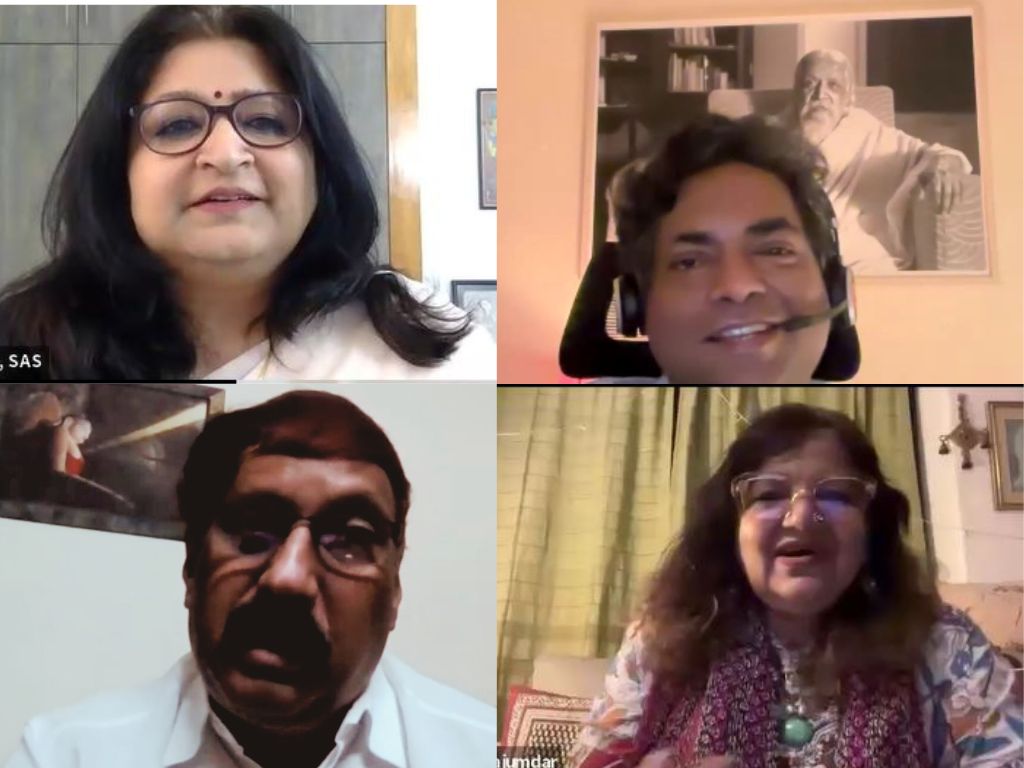
The first speaker Gayatri Majumdar presented on the topic — “Growing Up with Rabindrasangeet”. She spoke about how Rabindrasangeet has been an integral part of her life since childhood due to the influence of her mother who was deeply into it. Thereafter, she treated the participants to a song (Amar shakal niye boshe achi) performed by Kanika Bandopadhyay who was a great exponent of Tagore’s songs.
She also talked about a few other great performers of the genre whose songs she had been listening all her life and displayed a list of some legendary songs including the famous Jadi tor dak shuney na ashe (If no one comes hearing your call) which was written for Gandhiji.
Gayatri Majumdar acknowledged her debt to Tagore in shaping her personality and worldview and concluded with a wonderful quote from Gitanjali: Let all my songs gather together their diverse strains into a single current and flow to a sea of silence in one salutation to Thee.
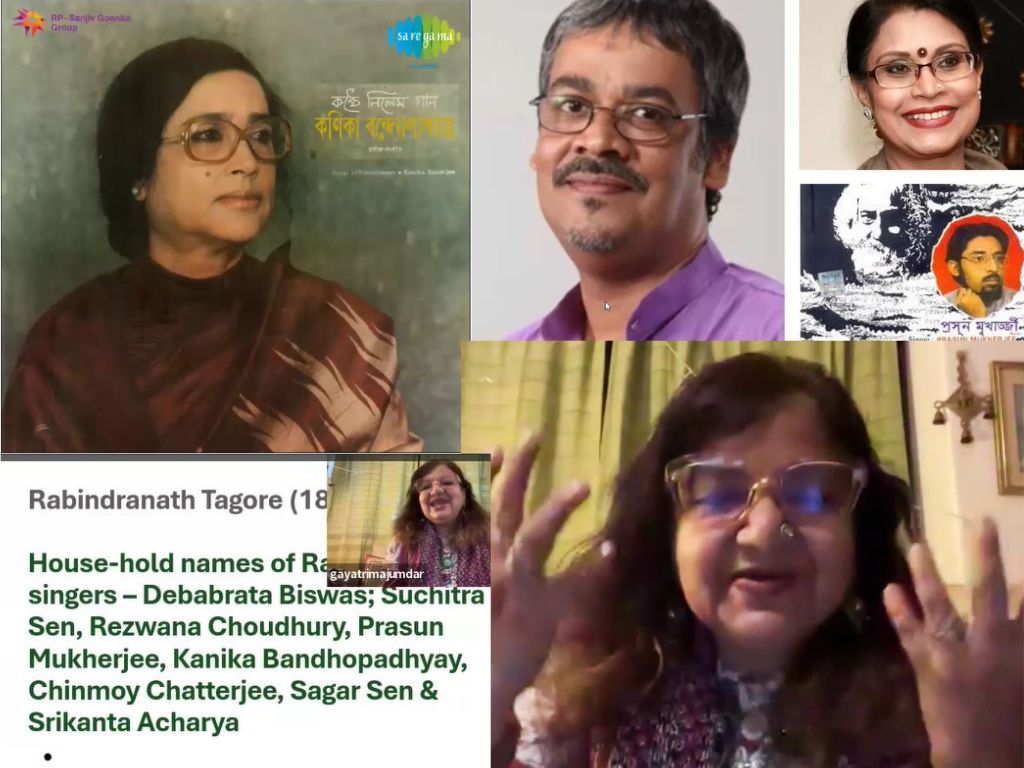
The next speaker for the day, Jishnu Guha, spoke on the topic “My Tagore: The Traveller of the Upward Way.” He shared some photographs of Tagore with the Mother and informed the audience that Tagore had actually asked her to take the responsibility of his visionary educational project which was to become Santiniketan later. Much of his presentation was focused on the various eminent people who were associated both with Tagore and Sri Aurobindo including Dilip Kumar Roy, Sahana Devi, Nishikanto, Jayantilal among many others. He highlighted a few details about these luminaries bringing out the common quest that inspired them.
Jishnu Guha also talked about the reverential regard that Tagore had for Sri Aurobindo though the latter was younger in age and also comparatively lesser known than the world-renowned poet at that time. He cited the poem Tagore had written on Sri Aurobindo “Aurobindo, Rabindrer loho pranam” in 1907 and again reiterated it in 1928 when he met him in person.
Sri Aurobindo had also declared that Tagore too “was a wayfarer towards the same goal as ours in his own way”. Jishnu Guha also brought out the consonance in both Tagore’s and Sri Aurobindo’s thought about acceptance and affirmation of life, shunning the idea of renunciation and about the future destiny of man by quoting some lines from Gitanjali and Savitri. He ended his talk by presenting how the great cultural icons of modern times have been influenced by Tagore.
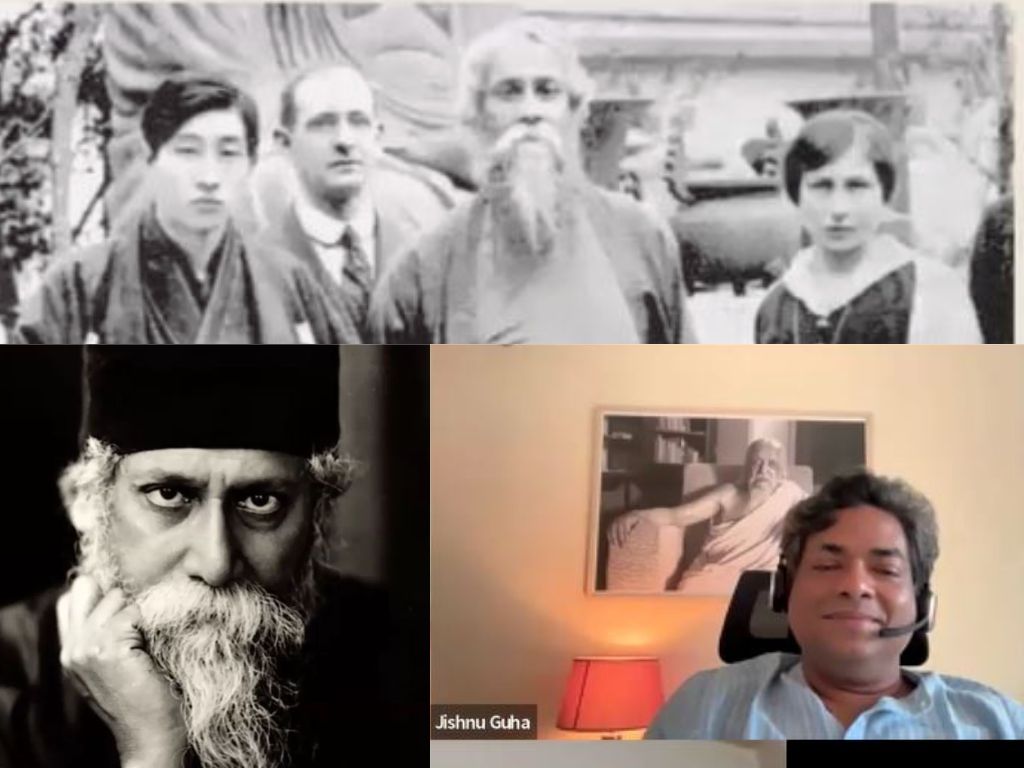
Thereafter, Dr. Beloo Mehra spoke on the topic, “Out of the Golden Cage: Tagore’s Insights on Education.” She began by saying that the two important things which shaped Tagore’s views on Education were: his own personal experience with the then prevailing education system, and his ideas on the kind of education that was needed for cultural and national reawakening. He was against the British way of learning that laid emphasis on the curriculum rather than the learner (a situation which holds true in much of the mainstream education even in the present day, unfortunately). Dr. Mehra said that Tagore claimed that such an approach was against God’s intention of how children grow into knowledge.
Understanding the deep significance of the idea of Brahmacharya in the formative years of a learner’s life, and also the deeper intention behind Guru-griha vas, Tagore experimented with these in the school he started. For Tagore, the purpose of education was the fullest growth and freedom of the soul.
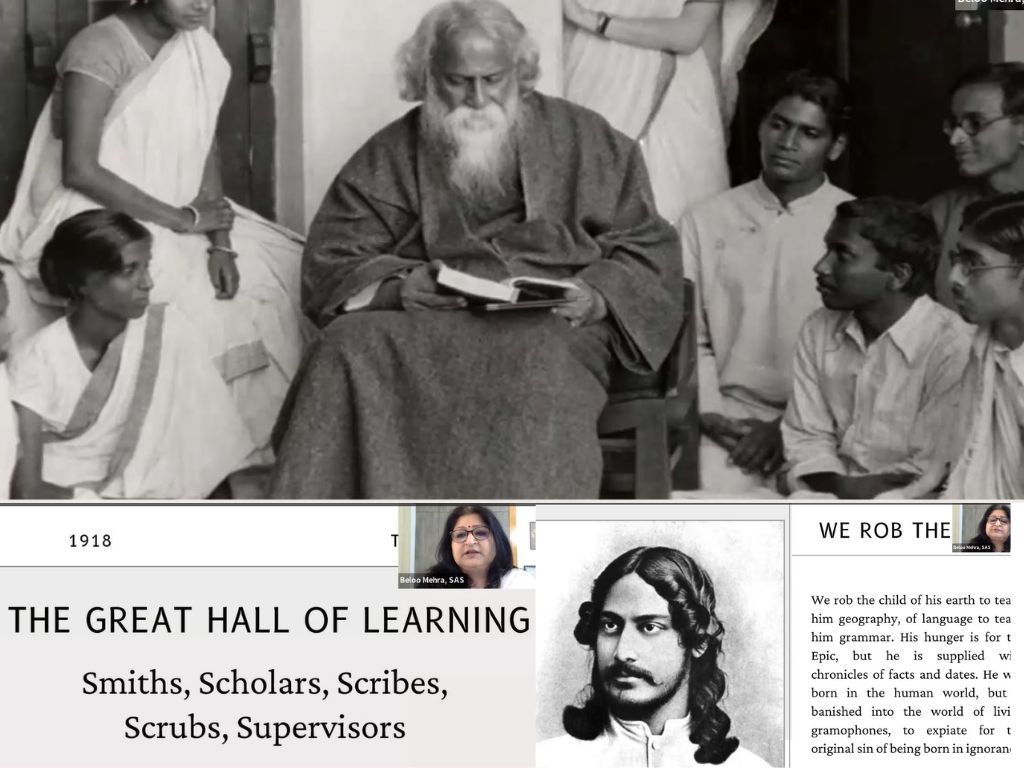
Dr. Mehra cited Tagore’s satirical short story Tota Kahini where a parrot was kept in a golden cage to be stuffed with book leaves for education which finally led to its death. She also talked about Tagore’s insights on Freedom, Nature, Beauty, Harmony and Unity of Truth and how they can be applied in an educational program.
She also focused briefly on Tagore’s insights on decolonising the education which included emphasis on the Mother tongue as medium of instruction and students becoming aware of the history and culture of the land instead of blindly imitating the Westerners. Dr. Mehra ended her presentation by highlighting the mission statement of Vishva Bharati “Where the whole world meets in a single nest”.

The final speaker at the webinar, Narendra Murty spoke on the topic “Tagore, The Mystic.” He began by saying that Tagore’s mysticism is very pronounced in three categories of his work – Prakriti, Prem and Puja. Tagore called his religion “A Poet’s religion”. The two main influences on Tagore’s mysticism were: the philosophy of the Upanishads and the spiritual path of the Bauls.
Narendra Murty reminded the audience that Tagore had stated that his first experience of the Divine was through Nature and he actually described vividly how he sensed the Divine while watching a sunrise. Though Tagore believed in the formless God, he saw the reflection of the Divine in all the forms of the world: in colours, fragrances and sounds.
Tagore believed that the Divine created the world to enjoy Himself in infinite forms. Narendra Murty illustrated this by presenting selected lines from some of the songs from Gitanjali where this thought has been expressed lyrically. Tagore’s philosophy was life affirmative and he took delight in every form and was vehemently against world negation.
Tagore viewed himself as a child playing in the garden of the Divine and even viewed Death as a beloved guest who must be offered a well-lived life when he arrives at the door. All the earnings and gleanings of my busy life will I place before him; At the close of my days when death will knock at my door – that was how Tagore viewed Death. Narendra concluded that if Buddha was a Dukkhavadi who talked about Dukkha and suffering, then Tagore had to be an Anandavadi who always sang about Ananda and delight in God’s creation.
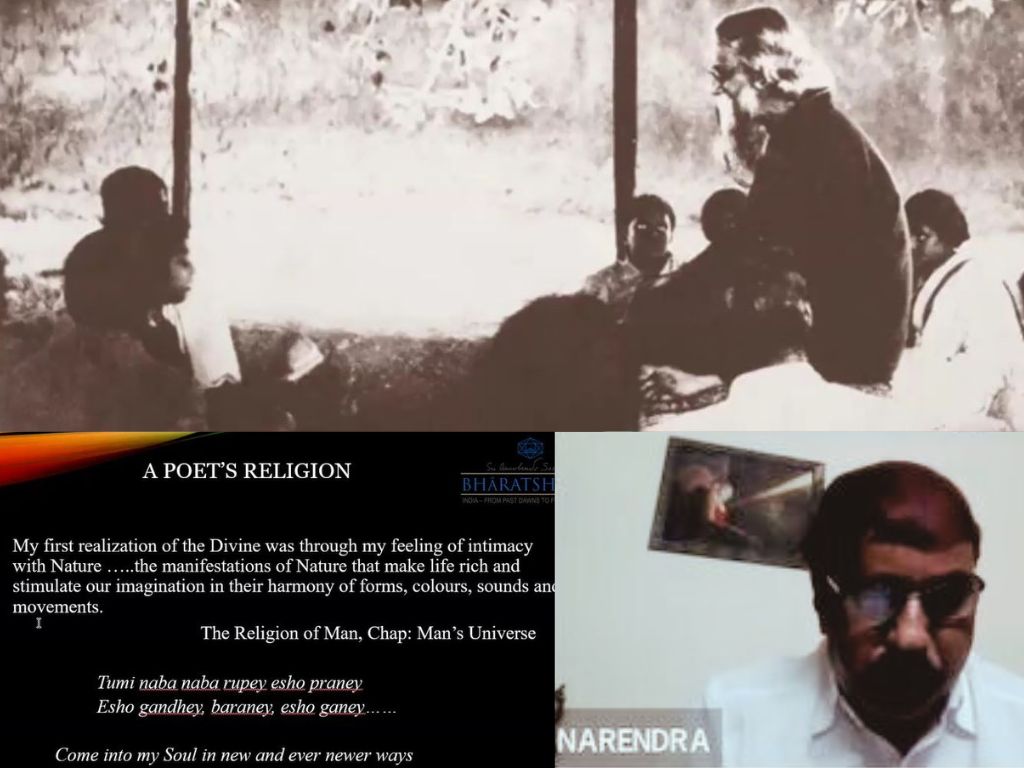
The webinar came to an end with a Rabindrasangeet offering by Indrajeet Ghose, one of the participants. The 2-hour-long programme was appreciated by the participants. Here is some sample feedback:
- Very enlightening insights, I’m grateful for all that you shared.
- Thank you. This was rich and loved knowing so much about Gurudev.
- Thank you all. For the wonderful presentation of Tagore
- Really happy to get so much info about SriAurobindo and KobiGuru.
- Very enlightening and enriching thoughts. Especially the blend of the ideas of Gurudev’s poetic spirit and Rishi Aurobindo’s vision.
- Wonderful inputs. Indeed, very enlightening and thought provoking
- Thank you for such an enlightening session. Heartfelt thanks for the invitation.
- Thank you all for a rich and delightful speeches and of course that song.
- Thank you for a great evening on Rabindra Jayanti
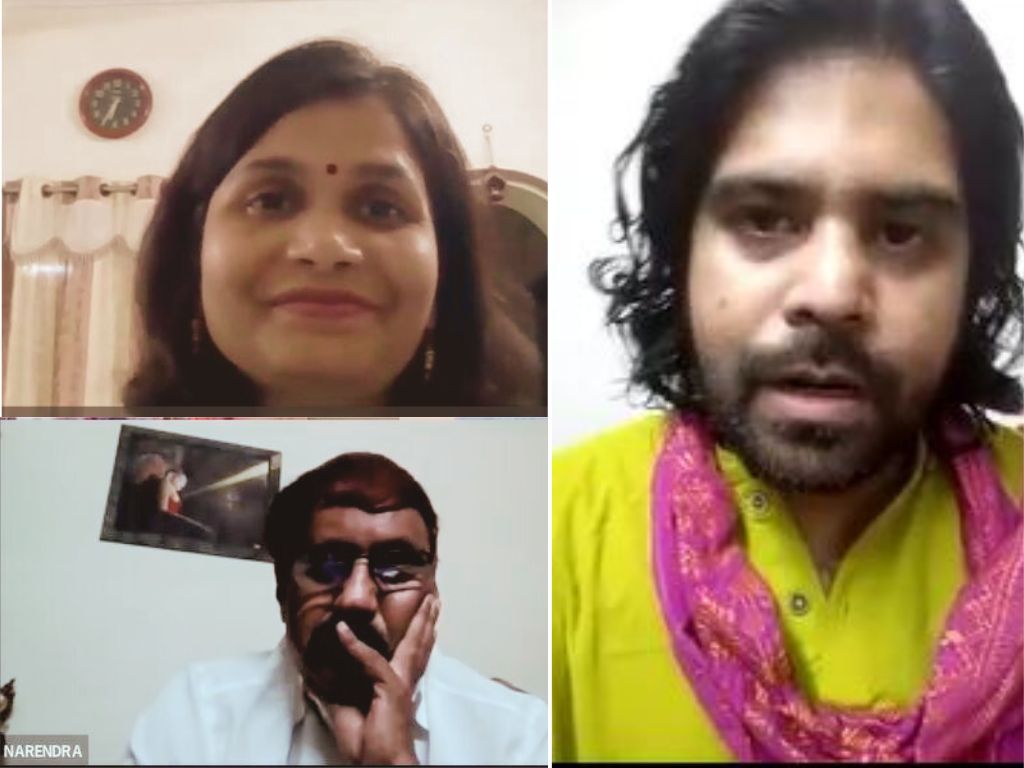
About the speakers:
Gayatri Majumdar is founder, editor, publisher of critically acclaimed literary journal, The Brown Critique and is currently associated with AuroPublications, Sri Aurobindo Society. Author of several books, she is widely published in numerous Indian and international journals and anthologies.
Jishnu Guha is a student of Integral Yoga, and takes a keen interest in Indian Art. He is a Chartered Accountant by profession and also holds an MBA degree. He volunteers his time toward preparing the newsletters of Sri Aurobindo Center, Los Angeles, delivering talks for workshops organized by NAMAH, Pondicherry and writing articles for Renaissance, the online journal of Sri Aurobindo Society.
Beloo Mehra serves as Director of BhāratShakti, Sri Aurobindo Society and Editor, Renaissance. A former professor at an American university, she has now devoted herself to Sri Aurobindo Studies as a student, researcher, writer, educator, program designer and editor. Author of several books and articles on topics related to Integral Education, Indian culture, social-cultural evolution, and Integral yoga, she has also worked with university students in India and the US.
Narendra Murty is a Research Associate at BhāratShakti, Sri Aurobindo Society and writes regularly for Renaissance. Retired from a managerial position in the insurance industry, Narendra’s deep passion has been the study of various religions and philosophies — both Eastern and Western for more than 3 decades. He is an award-winning author of six books.
